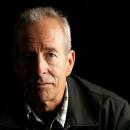Marty Balin, co-founder of Jefferson Airplane, dies at 76
- Share via
It was emblematic of the turbulent path San Francisco’s Jefferson Airplane navigated in the 1960s and ‘70s that when the group showed up to play a 1969 festival that was supposed to be the West Coast version of Woodstock, founding member Marty Balin got knocked out cold.
The event was the Altamont Festival, cooked up and headlined by the Rolling Stones. Held four months after Woodstock outside of San Francisco, Altamont failed to replicate that event’s touted “three days of peace and music” and turned tragic when a concert-goer was stabbed to death by a member of the Hells Angels motorcycle club, which the Stones had hired to provide security.
“I didn’t think anything of the Hells Angels doing security, because I didn’t know that’s what they were there for,” singer, songwriter and guitarist Balin told The Times in 1994 around the 25th anniversary of that show.
“I’d always seen them at Avalon and Fillmore shows, and there was never any trouble,” Balin said. “But when we were playing, I saw these guys hitting people with pool cues right in front of the stage. I thought somebody should be doing something, so I jumped down and tried to break things up. The Angels were a little surprised. One of them said, ‘Marty, what are you doing down here? You’re gonna get hurt.’”
In fact, while Balin was trying to break up one fight, someone hit him from behind and knocked him unconscious. Word of the incident prompted the Grateful Dead, which also had been scheduled to play, to pack up and leave, and the concert further devolved and eventually left four concert-goers dead.
Balin died Thursday at 76, according to a spokesman for the family. His cause of death was not immediately available, spokesman Ryan Romanesko said, but added that he died in Tampa, Fla., en route to a hospital with his wife, Susan Joy Balin.
The Altamont incident was reflective of the wild state of rock music in late-1960s, and for a time, Balin and his co-horts in the Airplane — singer Grace Slick, Paul Kantner, guitarist Jorma Kaukonen and bassist Jack Casady — were considered key players.
Balin, whose real name was Martyn Jerel Buchwald, was born Jan. 30, 1942, in Cincinnati, to Joseph and Catherine Eugenia Buchwald, and moved with his family as a boy to San Francisco, where he attended Washington High School.
Balin had been caught up in the folk music revival of the late-1950s and early-’60s, and in 1962 changed his name to Marty Balin. He recorded a couple of singles, “Nobody But You” and “I Specialize in Love” on his own before joining a folk quartet called the Town Criers.
It was on the folk scene, at a hootenanny, that he met guitarist Kantner and, in 1965, along with Casady, Kaukonen, drummer Skip Spence and singer Signe Toly Anderson formed the first iteration of the Jefferson Airplane at a club, the Matrix, which Balin had bought and converted from a pizza parlor.
Their 1966 debut album “Jefferson Airplane Takes Off” quickly found a national audience, in part due to enthusiastic reviews from San Francisco Chronicle critic Ralph Gleason, and sold more than 500,000 copies to qualify for gold sales status.
“Marty was the one who started the San Francisco scene,” his onetime roommate Bill Thompson, manager the Jefferson Airplane and Jefferson Starship, once said of Balin.
Balin’s importance to the group was evident in the fact that one of his songs, “It’s No Secret,” was selected to be the first single from the album.
“Back in those days Marty was quite the businessman,” Kantner said in the same statement. “He was the leader of the band on that level. He was the one who pushed us to do all the business stuff, orchestrating, thinking ahead, looking for managers and club opportunities. He was very good at it.”
In an early sign of what was to become a hallmark of the ever-evolving group, Spence left shortly after the album was recorded; a few months later, after giving birth to her first child that year, Anderson also quit the band, setting the stage for the classic lineup that would vault to superstar status after Grace Slick joined to share lead singing duties with Balin and Kantner.
The new lineup recorded “Surrealistic Pillow,” a 1967 album considered a quintessential work of the emerging psychedelic music scene that flowered out of San Francisco and yielded the hit singles “White Rabbit” and “Somebody to Love,” along with Balin’s “Plastic Fantastic Lover,” “3/5 of a Mile in 10 Seconds” and the ballad he wrote with Kantner often cited as one of the group’s finest, “Today.”
“White Rabbit” was widely considered an anthem to LSD, and caused many pop radio programmers to steer clear of subsequent Airplane singles. The group also took on political issues, sometimes making their music too hot to handle for controversy-shy radio outlets.
Yet the group was chosen as one of the headliners for the first major rock festival, the 1967 Monterey International Pop Festival. The event was a springboard to fame for then-rising acts Jimi Hendrix, Janis Joplin and Otis Redding.
Jefferson Airplane also was a marquee name two years later at Woodstock, and subsequently at Altamont. Yet as Slick’s commanding voice and onstage presence helped lift the band’s profile, it simultaneously reduced Balin’s profile.
Kantner and Slick, who later became romantically involved, slowly took over the reins of the band, and moved it in a heavier direction that appealed less to Balin’s more folk and pop-leaning taste.
The final album by the late-1960s lineup was “Volunteers,” which reached No. 13 on Billboard’s national album sales chart, helped along by the success of the title track, another Balin song.
Balin began to distance himself from the group in 1970 and officially quit in 1971. He decided, following Joplin’s death that year, to adopt a healthier lifestyle and began practicing yoga and gave up drinking and drugs.
But by the mid-1970s, he had patched things up with Kantner to rejoin the fold as the group became Jefferson Starship, with Casady and Kaukonen having departed to start Hot Tuna.
Balin’s pop instincts came to the fore again, and he wrote the new band’s 1975 hit “Miracles,” which reached No. 3 on Billboard’s Hot 100.
Only three years later, however, he had soured on touring and Slick’s battles with alcohol, and left for a solo career, releasing his first solo album, “Balin,” from which two singles “Hearts” and “Atlanta Lady” were released.
In the mid-1980s, Balin, Kantner and Casady came together again as the KBC Band, which had little commercial success. While on the field at San Francisco’s Candlestick Park in 1984 to sing the national anthem before a Giants game, Balin forgot some of the words, prompting fans to boo him.
Later, for the first time since 1971, Balin rejoined Kantner, Slick, Casady and Kaukonen in 1989 for a short-lived Jefferson Airplane reunion tour. Four years later he returned to perform with Jefferson Starship, and left one last time in 2008.
The 1966-1970 lineup of Jefferson Airplane was inducted into the Rock and Roll Hall of Fame in 1996, which lauds the group “as experimental revolutionaries,” further noting that “Jefferson Airplane’s career was one of hits punctuated by controversy, both from internal conflict and their own wild political views.”
Balin also enjoyed painting through most of his life, and painted portraits of many rock and pop music contemporaries, many of whom he considered friends.
In addition to his wife, Balin is survived by daughters Jennifer Bailey and Delaney Balin and stepdaughters Rebekah and Moriah Geier. No services have been announced.
Twitter: @RandyLewis2
More to Read
Start your day right
Sign up for Essential California for the L.A. Times biggest news, features and recommendations in your inbox six days a week.
You may occasionally receive promotional content from the Los Angeles Times.







